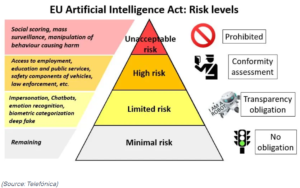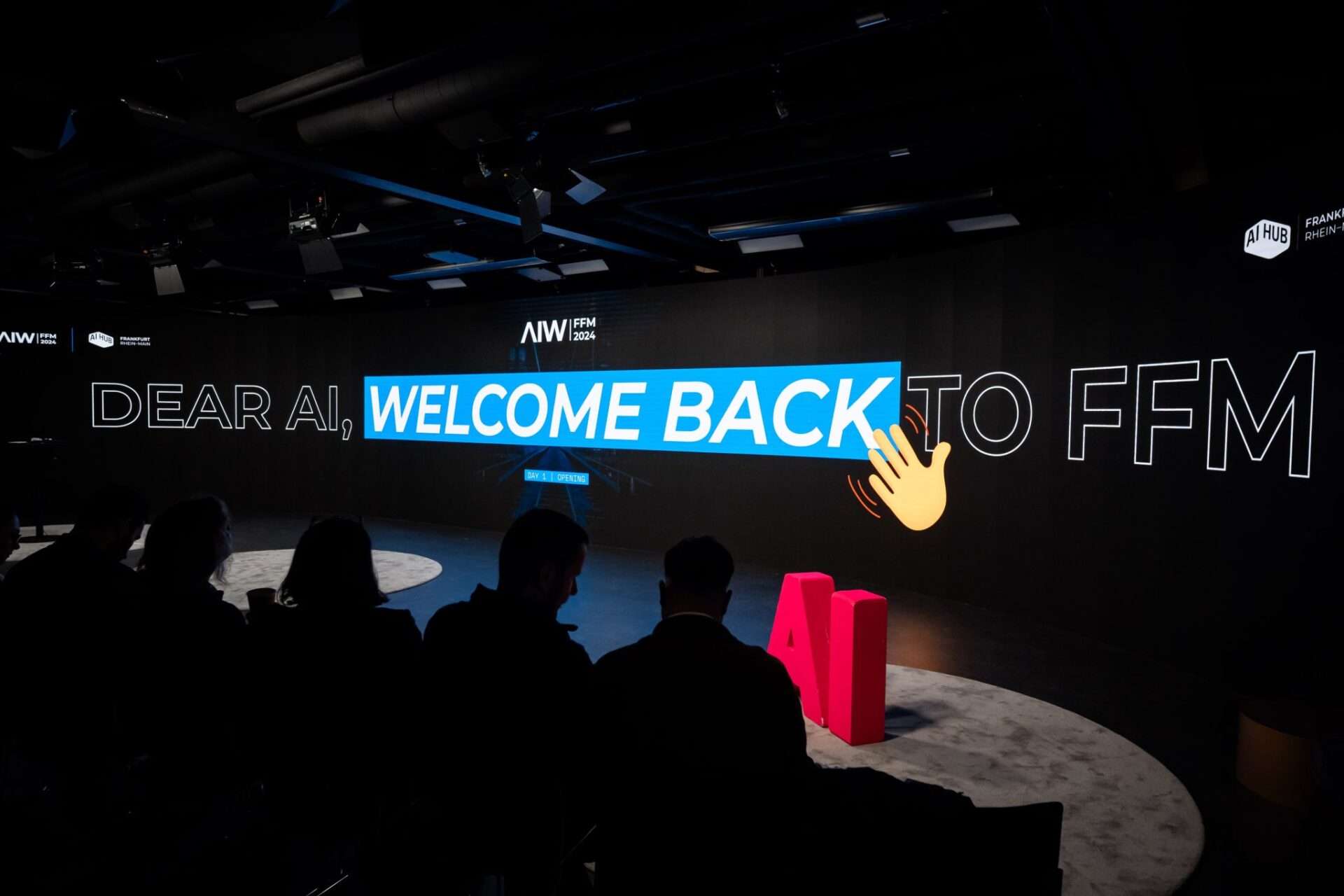Most AI solutions are still in the development phase and there are many limitations and uncertainties. Large organizations are still waiting for detailed, proven documentation to deploy these often-capital-intensive products. Marketing with content creation and communication can help to bring this technology closer to people and exploit the synergies.
After spending some time with industry leaders during AI Week in Frankfurt, AI enthusiasts got an overview of the status quo of how the different industries perceive and how they use or plan to use AI-driven technologies.
This article provides a deep dive into the expectations of leading companies towards AI technology and the expectations of AI-driven use cases in the fourth quarter of 2024 in Germany.
The State of AI Adoption in Germany
Recent research by digital economist Dr. Holger Schmidt shows that productivity in the EU, particularly in Germany, is declining compared to the US. Statistics show that only 13% of German companies are actively using generative AI in their processes and 21% of the companies are “value seakers”. They are still working on unlocking the value of GenAI. Considering these figures, it is high time for companies to innovate more and utilize machine learning technologies.

Source: https://www.linkedin.com/feed/update/urn:li:activity:7254008129963675648/
The introduction of GPT4 represents a significant advance in AI language models, as they are able to produce human-like quality text, translate languages more accurately and write different types of creative content. Majority of the companies are utilizing the automation because everyone admits that it is the catalyst for business. There are still many companies that claim time, money and energy savings are the only values for AI-driven technologies, but the reality is much more complex.
The Promise and Peril of AI Technology
The AI Week in Frankfurt was a real eye-opener to see how data-driven AI technology could change our lives and be used in large companies. According to Maurice Engelhardt of the Stada Group, there are a variety of challenges and risks that most companies face when working with GenAI, from the many ideas that vendors and consultants can put forward, to the thousands of internal requests to automate curtain processes. The technology landscape is dynamic, with new tools and platforms popping up every day with the promise that they will make overall business processes smarter and better.
Many people are afraid of missing out on something important. Technological progress is making things cheaper, faster and more intuitive. Yet many companies are still waiting because they feel unsettled by government regulations. The EU AI Act law will soon come into force, but we all remember how the General Data Protection Regulation was introduced and how much uncertainty it caused.

Source: https://www.telefonica.com/en/communication-room/blog/a-fit-for-purpose-and-borderless-european-artificial-intelligence-regulation/
AI in Banking: Automating Compliance and Customer Care
Regulations were also in the main focus during the banking and finance sector discussions. They move with small but accurate steps keeping their eyes on following the strict rules and security. The European Central Bank’s representative Maria Franzi explained the huge administrative challenge what they face with the documentation what they constantly receive from all over the EU countries. Documents can be submitted in 24 official languages from the big variety of topics. Their focus is on automation and how to streamlined workflows in order to identify the document and send or save it at the right place. Moving forward to classic customer care implementations, Henry Byers from Zurich Group explained, the benefits of the dynamic email automation. Their approach is to segment the inquires and then tailor the user messages. They utilize the Retrieval-augmented generation (RAG) system, which is a technique for enhancing the accuracy and reliability of generative AI models with facts fetched from external sources. The process is the following: once a ticket comes in, they distinguish what is the intention and the category. Then they check the content type, which knowledge does the ticket require and then the system decides, if a personal or system-generated answer is more desirable than they generate an answer accordingly. The basic idea was to make the customer care responses more dynamic and use the machine for generic inquires and human resource for complex problem solving.
Ensuring AI Trustworthiness: Privacy, Transparency, and XAI
When it comes to data analysis and the use of the technology, privacy and transparency must be critical points for adoption. During the sessions, it was a common and fundamental requirement to have a secure and closed system that is able to provide explainable details on how the AI model uses the data and what factors were considered during the decision-making process. This is what is known as explainable AI (XAI). During the process, the machine can confuse or ignore data, leading to AI hallucinations. It is a basic need for companies to minimize such effects as much as possible in order to obtain a reasonable result at the end of the process.
Balancing Technology and Human Expertise
While these points may seem technical, precise use cases are crucial to reassure future users that the machine will meet their needs. This is in line with the human-in-the-loop concept, a collaborative approach that incorporates human input and expertise into the lifecycle of machine learning and artificial intelligence systems.

Source: https://cobusgreyling.medium.com/ai-agents-with-human-in-the-loop-f910d0c0384b
In addition to internal technological requirements, giants like Deutsche Bahn have thousands of employees with completely different levels of education. They must continue to focus on training them, otherwise the rollout will not be successful. If employees are afraid of losing their jobs due to the new technology, they will not participate and the whole project will fail.
From a human perspective, successful AI-driven implementations are dependent on community management. The way companies introduce the technology to their employees and how they engage them is critical. From my own experience, I know that the more people on board, the more successful the platform will be. At this point, companies are focusing on presenting smaller AI-driven use cases such as email generation or text translation to familiarize themselves with the technology. As a best practice, Jasmin Weilmüller emphasized in the BASF presentation how important it is to empower all colleagues to increase the adoption of the new AI solutions. Providing comprehensive materials, practical use cases on how to use the solutions effectively, conducting pilot projects with early testers and integrating the new applications into the already existing ecosystems.
All employees need to be sure that their work is safe, valued and valuable. It is important that decision makers are clear about how much time and effort the project will take, who from the team should be involved and what they need to do to harmonize with the already existing ecosystem.
Agile Innovation with AI
AI-driven software makes the whole development agile, especially with mini GenAI apps tailored to specific small business cases. Bayer Group representative Sarah Levandowski emphasized that agility is a highly appreciated value as it enables organizations and individuals to quickly adapt to change, innovate and seize opportunities. The regular revision of small use cases and technologies also reduces the feeling of disinvestment in the leadership team.
The AI Paradox: Why Big Tech Hesitates
The bigger the company the less adventures can it be with futuristic ideas. Implementing a new tool and set it up-and-running can be taken years due to the administrative issues and IT requirements. No wonder that the bigger companies are still in waiting-mode and asking as much as possible evidences and trainings.
AI is already shaping the world of technology, and there are many uncertainties. Use cases are the way to build trust and get decision makers to scale it in their organizations. Many innovators and companies are ready to do our jobs better, but they need to understand the common challenges and fears and communicate better to win people over to their products and solutions.
About the author:
Let’s make things #zSofisticated!
Zsofia Raffa is a global digital marketing strategist with a journalist’s heart! With over 15 years of rocking the marketing world, she’s helped brands like Kodak, NVIDIA, Black Rock, and Lufthansa to shine digitally.
She’s all about turning data into stories that wow. As a regular newspaper writer, Zsofia knows how to make numbers turn into capturing attention. LinkedIn is her special field – she’s mastered the art of social selling, lead generation, and turning employees into brand ambassadors.

